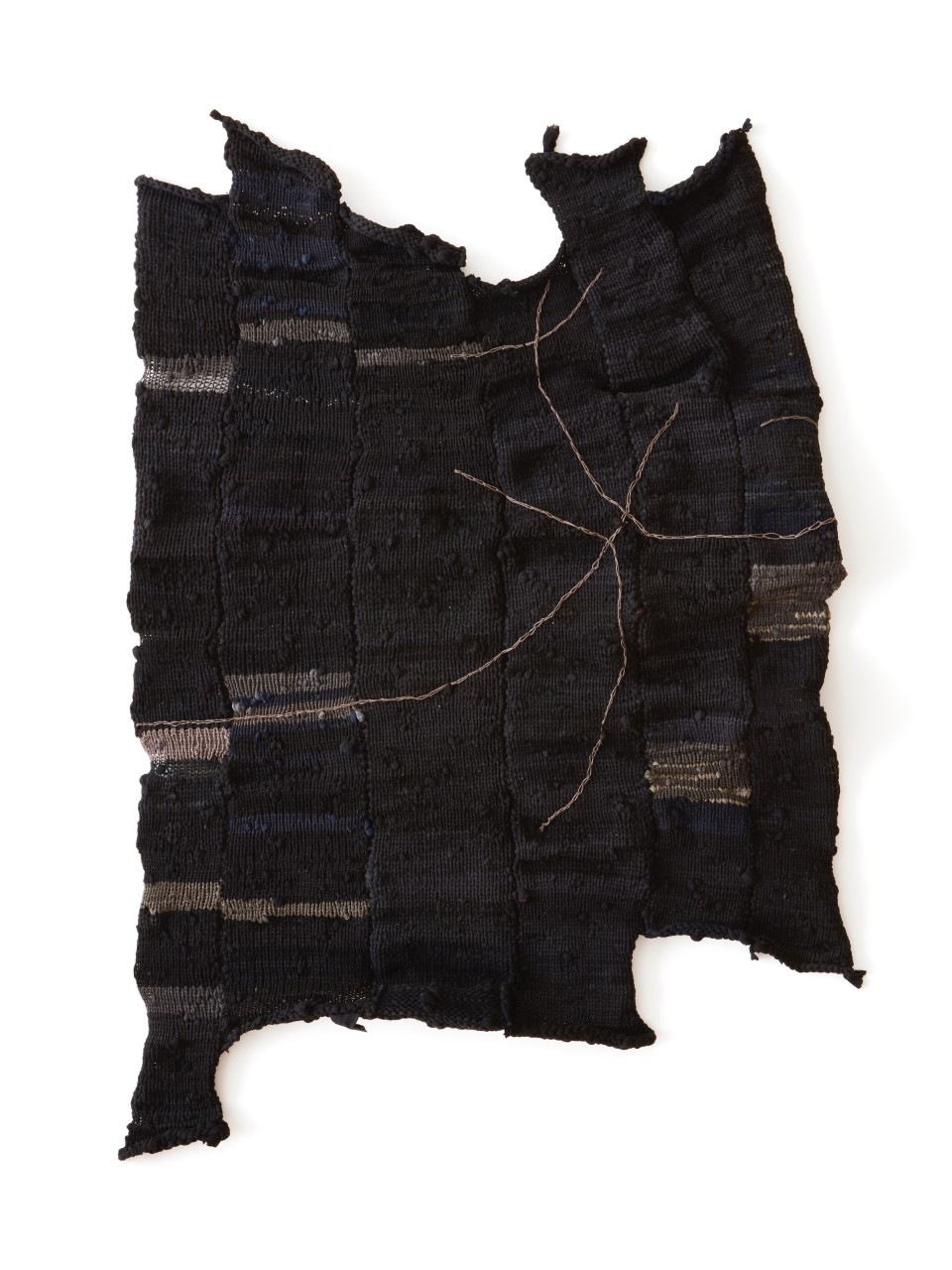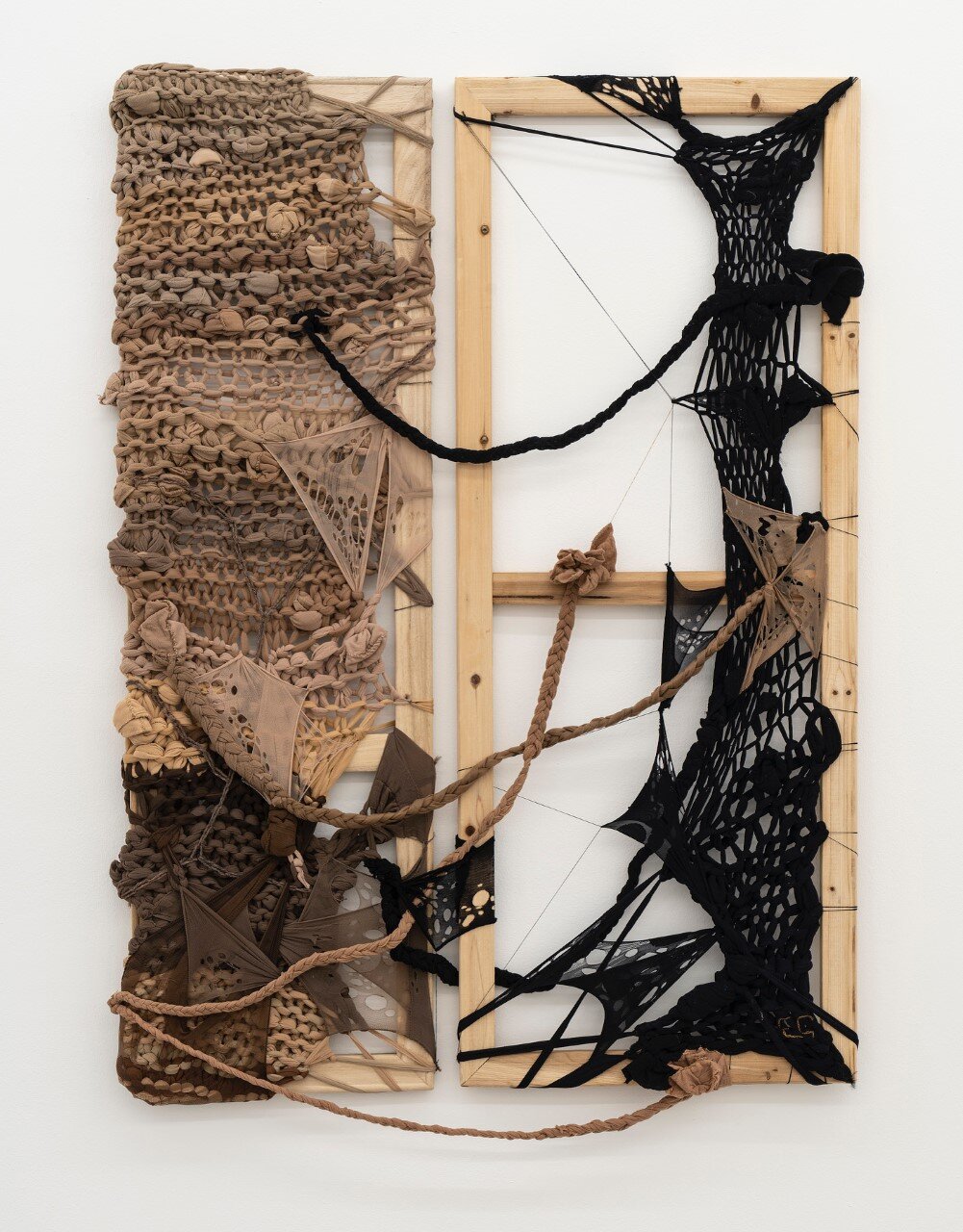Enam Gbewonyo - textile and performance artist
Enam Gbewonyo is a textile and performance artist. Over the last few years her work has been framed around how a simple garment such as nude tights can marginalise black women. She is working towards being a net zero artist and using sustainable materials throughout her practice and in her way of life. Enam is on the panel for the Sustainability First Art Prize.
From left to right. 1. Resting Black Face, 2020, hand knit used tights and recycled cotton yarn. 2. Femininity and blackness: a Pointe-d dreamscape in nude, 2019, recycled tights and cotton thread on vintage wood frame. 3. Colonialist ravelry, an infection of mind, skin and being. Blackness hangs on, a determined survival! recycled tights and cotton thread on vintage wood frame 4. The Empire has new clothes, a history rewritten in the Black I, 2021, used tights, wool and acrylic yarn, cotton thread and eco-friendly water based acrylic paint on used empty canvas frame. All images provided by artist.
Tell us about your journey as an artist and your practice
I’ve been practicing for over ten years but prior to this worked in fashion design for seven years and primary education for two years. I studied Textile Design and so my practice is heavily based on materiality and at its crux advocating for the healing benefits of handcrafts. Since 2016 my work has been framed around nude tights as a way of highlighting how a simple garment can marginalise black women making them feel invisible. Through my body of work, which includes performance, I chart the history of the garment and how that intersects with black women. It is a history that crosses the eras of Empire, slavery and colonisation, the 1920s and Windrush where I highlight the immeasurable contributions of black NHS nurses.
The work also uncovers the impact of these periods on black women’s mental health and wellbeing, namely generational trauma. This has become a specific focus of my performance work in providing healing for black women. More recently I have been delivering workshops aimed at bringing intergenerational groups of black women together to explore these themes more intimately.
I also address the harmful impact of the hosiery industry on the environment both in its production and disposal. My work in itself becomes a solution, now using only used and recycled tights to create the pieces thereby closing the loop. As a result I am working towards being a net zero artist and do my utmost to use natural/ sustainable/used materials across not just my practice but also my way of life.
How has the pandemic changed how you work?
The pandemic has been a period of reflection and introspection. I really focussed on my own healing which has in turn made me so much more intentional about my practice. I am much more mindful of the environment in which I work and how I am feeling in my body. I believe that metaphysically, this energy is channelled into the work so if anything feels off/ inauthentic then it needs resetting so that the right energy feeds the work.
What has also been a revelation for me during this period is online performance. I’ve always believed that performance needs to be experienced live, in person. Yet with the ability to do so taken away I was still able to deliver three performances via livestream very successfully, one of which was very technically involved and so could only have been achieved by digital means. The reception of each of these performances left me so humbled at how impactful performance can be sometimes even more so when delivered digitally.
You are on the panel for the Sustainability First Art Prize, can you tell us about the Art Prize and how the selection process works?
I’m so excited to be a judge in the second ever Sustainability First Art Prize, it’s all happening later this year and I can’t wait to see all the entries. Sustainability First established the prize last year as a result of the pandemic and it runs alongside a Writing Prize. This year’s theme is Together for a Fair Climate Future, which is interested in works that address the climate crisis, fairness in society, and that posit solutions on how we work together to achieve a more sustainable future. The winning artist will receive £1,000 and the second and third prizewinning artists receive £500 and £300 respectively. The deadline for submissions just closed on 31 July so now begins the longlisting process and then shortlisting in September. The winners will be announced at Sustainability First’s conference at the end of September.
The prize is actually part of Sustainability First's wider Sustainable Futures programme. The programme focuses on how we can recover from the Covid-19 pandemic in a way that's fair, innovative, and positive for the environment. It’s a fantastic programme that includes online discussion events, schools outreach workshops, work with artists in communities along the North Sea, the aforementioned conference on culture change and culminates in a call to action at COP26 - the UN climate change conference being held in Glasgow this November.
What are the top one or two things artists or the wider art world could be doing to make a change sustainably?
Two very simple things that would make huge strides in terms of sustainability in the art world as a whole are; a) if we all recycled bubble wrap or used more sustainable ways to wrap artwork such as using eco-friendly bubble wrap or artpakks/stiffy bags which can be reused multiple times. Artpakks are particularly good as the fabrics used in the bags are non-toxic and are recyclable b) if everyone switched to using Kraft paper packing tape which is fully recyclable rather than the icky brown plastic tape.



